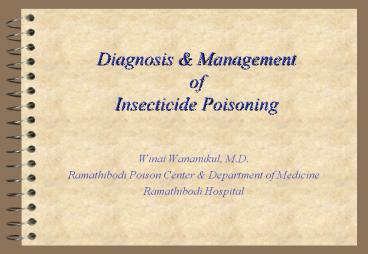Diagnosis & Management of Insecticide Poisoning - PowerPoint PPT Presentation
1 / 43
Title:
Diagnosis & Management of Insecticide Poisoning
Description:
Diagnosis & Management of Insecticide Poisoning Winai Wananukul, M.D. Ramathibodi Poison Center & Department of Medicine Ramathibodi Hospital Epidemiology of Toxic ... – PowerPoint PPT presentation
Number of Views:1202
Avg rating:5.0/5.0
Title: Diagnosis & Management of Insecticide Poisoning
1
Diagnosis Management of Insecticide Poisoning
- Winai Wananukul, M.D.
- Ramathibodi Poison Center Department of
Medicine - Ramathibodi Hospital
2
Epidemiology of Toxic Exposure(May 2000 - April
2001)
3
Classification of Pesticide Exposure
4
Classification of Insecticide Exposure
5
Classification of Herbicide Exposure
6
Classification of Rodenticide Exposure
7
Ratio of Exposure with and without clinical
manifestation of poisoning at the time consult
to the Poison Center
8
Medical Outcome of the Risk Group
9
Medical Outcome of the Poisoned Group
10
Medical Outcome of Selected Toxic Exposure
11
Survival Death Rate of Selected Pesticide
Exposure (from high to low mortality rate)
4.2
2.5
1.6
22.9
20.0
42.3
61.3
12
Organophosphate andCarbamate Poisoning
13
What is Acute Organophosphate Carbamate
Poisoning ?
- State of Acetylcholine Excess
- It is a combination of
- Muscarinic receptor
- Nicotinic receptor
- CNS (unspecified)
14
(No Transcript)
15
Organophosphate VS. Carbamate Poisoning
- Reversible vs. Irreversible Inhibition
- Reversible vs. Irreversible clinical poisoning
- Time of clinical course
- Blood brain barrier penetration
- CNS symptoms (after exclude hypoxic effects)
16
Clinical course after acute poisoning
- Cholinergic Excess
- Others (than cholinergic excess)
- Intermediate syndrome
- Delayed neuropathy
- Arrthymias
17
Diagnosis of Organophosphate or Carbamate
Poisoning
- Clinical Diagnosis
- Laboratory
- Red cell cholinesterase
- Plasma (Pseudo, Butyryl (Bu)) cholinesterase
18
Management of OP CB Poisoning
- Supportive Care
- Vital signs
- Respiration
- secretion block and airway obstruction
- respiratory motor weakness
- Seizure
- Specific Treatment
19
Increase Elimination
Decontamination
Antidotes
Airway
Skin
Tissues Organs
Circulation
Parenteral
GI.
Ion Trapping
RAC.
Hemodialysis, Hemoperfusion
20
ANTIDOTES
TOXIC
21
Atropine
Muscarinic Effects Heart rate Sweating
Secretion Pupils
22
2 PAM
AChE Inhibitions Nicotinic Muscarinic
23
2 PAM
Nicotinic Effects Motor Power (Muscarinic
Effects)
24
Intermediate Syndrome
- Develop only after some acute organophosphate
poisoning - Mechanism unknown
- not directly relate to acetylcholine excess
- Clinical Manifestation
- Proximal muscle weakness
- Bulbar palsy
25
Intermediate Syndrome
- Spontaneous recover in 2 -3 weeks after develop
- Treatment
- Supportive care, especially respiratory care
- Note this condition must be differentiated from
Aged Acetylcholinesterase
26
Chronic Organophosphate Poisoning
- Clinical Features
- Delay polyneuropathy
- Neuropsychiatric disorder
- Diagnosis
- Clinical diagnosis, by suspicious exclusion
- Investigation
- ?? Plasmacholinesterase
- Treatment
- Not established
27
??????? 31 ?? ?????????? ?????????????
1/2 ??????????????????? ???????? Egodan ??????
½ ??? ?????????????????????????????????
??????????????. ??? ER ??????????? HR 140/min,
BP 160/110, RR 22/min ????????? generalized
tonic and clonic seizure ???????? ??? ET tube
intubation ??? iv fluid ??????? diazepam
28
??????? 31 ?? ?????????? ?????????????
- ???????????????????? unconscious
- Pupil 4 mm, react to light bilateral
- Lung clear
- Abdomen soft, normal bowel sound
- Neurological signs no stiff neck,
- motor power grossly intact,
- absent of Babinsks sign.
29
Organochlorine Poisoning
30
Classification of Organochlorine
- Dichlorodiphenylethanes
- DDT Methoxychlor
- Hexachlorocyclohexane
- Lindane
- Cyclodienes
- Aldrin Chlordane Dieldrin
- Endrin Endosulphan Hepatochlor
- Chlordecone (kepone)
- Mirex
31
Acute Organochlorine Poisoning
- Prodomal symptoms
- tremor, ataxia, quick involuntary jerk
(myoclonus) - dizziness, confusion
- Paresthesia of month,
- nausea, vomiting
32
Acute Organochlorine Poisoning
- The typical presentation Status epilepticus
- Followed by
- Respiratory failure
- Cardiac arrhythmias
- Rhabdomyolysis acute renal failure
33
Acute Organochlorine Poisoning
- Treatment
- Control seizure as the same way as Status
epilepticus - Benzodiazepines
- Phenobarbital
- Phenytoin
- Prevent complications
34
Diagnosis of Organocholine Poisoning
- Clinical Diagnosis
- History of exposure
- Clinical features of repeated seizure
- Laboratory Test
- Plasma level
- Subcutaneous fat level
35
Subacute Organochlorine Poisoning
- Hyperexcitability stage
- Tachycardia
- Tremor
- Hyperreflexia
- Treatment
- Symptomatic Px Anxiolytic
- Enhance Elimination Cholestyramine
36
Chronic Organochlorine Poisoning
- Organochlorine insecticides interfere with
endocrine and reproductive systems. - People who working with the insecticides have low
sperm count and motility, infertility and
abortion. - The insecticides have also been reported to be
carcinogenic to animals.
37
Pyrethroid Poisoning
38
Classification of Pyrethrins Pyrethroids
- Pyrethrins
- Cinerin I Cinerin II Justmolin I Jusmolin II
- Pyrethrin I Pyrethrin II Pyrethrum extract
- Type I Pyrethroids
- Allethrin Bioallethrin Cismethrin Kadethrin
- Permethrin Phenothrin Resmethrin Tetramethrin
- Type II Pyrethroids
- Cyhalothrin Cypermethrin Cyphenothrin Deltamethrin
- Fenpropenthrin Fenvalerate Fluvalinate
39
Pyrethroids Exposure
- Direct Toxic
- Hypersensitivity
- Allergic rhinitis
- Bronchitis
- Bronchial asthma
- Anaphylactic shock
- Local Irritation
- Contact dermatitis
- Corneal abrasion
40
Pyrethroid Poisoning Insect
- The type I syndrome (caused by type I
pyrethroids) - fine tremor
- reflex hyperexcitability
- sympathetic activation
- The type II syndrome (caused by type II
pyrethroids) - salivation
- coarse tremor
- choreoathetosia
- reflex hyperexcitability
- sympathetic activation, and seizure
41
Pyrethroid Poisoning Human
- Usually mild
- Common
- nausea and vomiting after ingestion of
pyrethroids. - Sever Cases drowsiness, seizure and coma
- ( In patient exposed to large amount of
pyrethroids, especially the product used in
agriculture in higher concentration) - Death from pyrethroid poisoning is rare.
42
Diagnosis of Pyrethroid Poisoning
- Clinical Diagnosis
- Laboratory Test
- None
43
Management of Pyrethroid Poisoning
- Hypersensitivity
- Adrenaline
- Corticosteroids
- Bronchodilators
- Antihistamine
- Direct Toxic
- Supportive treatment































